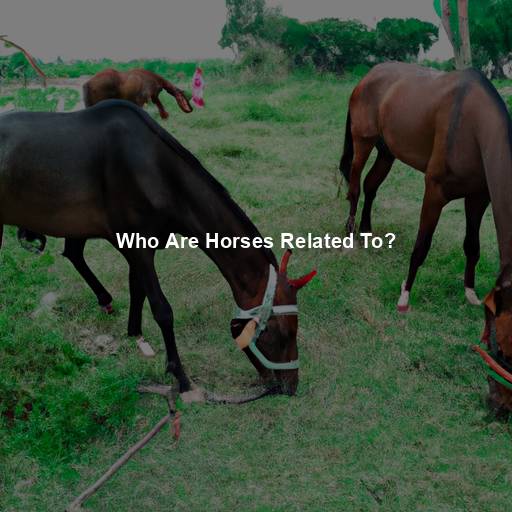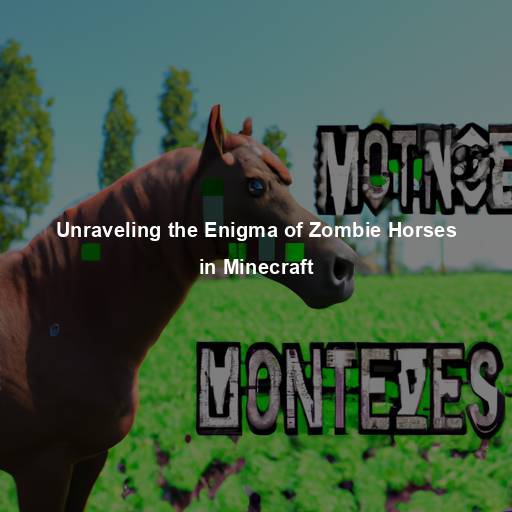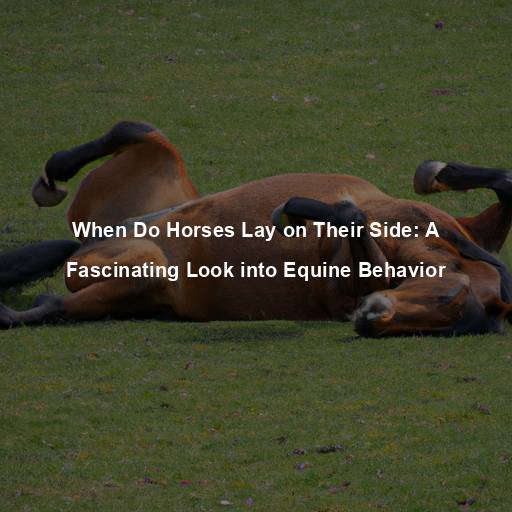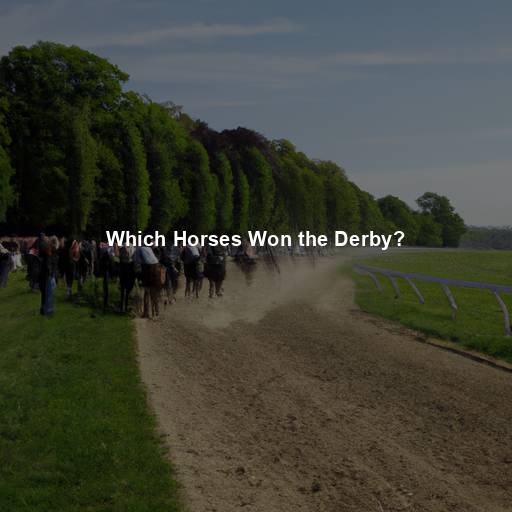Who Are Horses Related To?
Last Updated on July 25, 2023 by Evan
Contents
- 1 The Fascinating Family Tree of Horses
- 2 The Enduring Bond: Humans and Horses
- 3 FAQs – Who are horses related to?
- 3.1 What are horses related to?
- 3.2 Are horses closely related to zebras?
- 3.3 What about donkeys? Are horses related to them as well?
- 3.4 Are horses related to other non-equine animals?
- 3.5 How genetically similar are horses and their relatives?
- 3.6 Are there different breeds of horses within the Equidae family?
- 3.7 Do all horses have the same number of chromosomes?
- 3.8 Can horses reproduce with animals outside of the Equidae family?
The Fascinating Family Tree of Horses
Prepare to be entranced by the captivating allure of horses, as we embark on a journey through time to uncover their enigmatic lineage. In our quest for knowledge, we shall unravel the intricate ties that bind horses to their ancient and mysterious counterparts. Be prepared to have your imagination stirred and curiosity piqued as we delve into the remarkable tapestry of their evolutionary history. Join us as we explore the awe-inspiring connections that have shaped these majestic creatures and continue to mesmerize us with their beauty, strength, and elegance.
The Equine Family: Horses, Zebras, and Donkeys
At the heart of the horse’s family tree lies the Equidae family, which includes horses, zebras, and donkeys. These three species share a common ancestor and are part of the same genus, Equus. Despite their physical differences, they all belong to the same family and exhibit remarkable similarities in their genetic makeup.
Horses: Our Noble Companions
Horses, with their sleek bodies and flowing manes, have been domesticated by humans for thousands of years. They have been our loyal companions in transportation, agriculture, warfare, and even sports. From the powerful Clydesdales to the elegant Arabians, horses come in various breeds, each with its unique characteristics and traits.
Zebras: Nature’s Striped Wonders
Zebras, with their distinctive black-and-white striped coats, are native to the grasslands of Africa. These stunning creatures are known for their social behavior and strong herd dynamics. While zebras may appear similar to horses, their wild nature and striking patterns set them apart. Zebras have never been fully domesticated, making them untamed symbols of the African savannah.
Donkeys: The Humble Workmates
Known by various names such as “ass” or “burro,” donkeys have etched a peculiar place in human existence. From ancient times to the present day, these steadfast creatures have carved their niche as pack animals and trusty associates. With their diminutive stature and characteristic long ears, donkeys exude an aura of resilience and steadfastness. Their unwavering endurance enables them to effortlessly shoulder hefty burdens and conquer treacherous landscapes with ease.
The Surprising Relatives: Rhinos and Tapirs
While horses, zebras, and donkeys form the core of the Equidae family, their evolutionary journey takes us further back in time. Surprisingly, horses share a common ancestor with two other fascinating creatures: rhinoceroses and tapirs. Although their physical similarities may not be immediately apparent, the genetic connections between these animals provide a glimpse into their shared ancestry.
Rhinoceroses: Giants of the Grasslands
Marvel at the enigmatic beauty of rhinoceroses, majestic creatures that captivate with their colossal frames and awe-inspiring horns, embodying the essence of the wild. These plant-eating beings possess an undeniable adaptability, seamlessly flourishing across varied landscapes spanning the continents of Africa and Asia. Surprisingly, while their distinctive appearances may deceive us, the intricate bonds of their genetic composition unravel a celestial kinship with horses, as distant relatives in the grand tapestry of evolution. Delve into the veiled mysteries of time as the evolutionary paths of magnificent equines and these formidable giants diverged eons ago, paving the way for their astonishing existence today.
Tapirs: Ancient Creatures of the Forests
Tapirs, often described as resembling a mix between a pig and an anteater, are native to the jungles of Central and South America, as well as Southeast Asia. These solitary creatures have a unique trunk-like snout and are excellent swimmers. Surprisingly, tapirs share a common ancestor with horses, albeit from a much earlier era. Their ancient lineage provides a glimpse into the intricate web of evolutionary connections.
The Ancestors: Mesohippus and Hyracotherium
Journeying back through the annals of history unveils the enigmatic beginnings of horses and their kin – a tale brimming with intrigue and complexity. Casting our eyes upon the distant past, we encounter the formidable figures of Mesohippus and Hyracotherium, whose presence on the evolutionary stage proved instrumental in molding the destiny of these captivating beings. As we piece together the fragments of their stories, the panorama of their influence unfolds, leaving us both awe-inspired and perplexed by the enigmatic forces at play.
Mesohippus: The Dawn Horse
Mesohippus, meaning “middle horse,” roamed the Earth approximately 40 to 30 million years ago. This small, dog-sized creature had three toes on its front feet and four on its hind feet. While Mesohippus may appear vastly different from modern horses, it served as a crucial transitional species, paving the way for the development of the horse we know today.
Hyracotherium: The Eohippus
The enigmatic era of Hyracotherium, a fascinating creature sometimes referred to as Eohippus or the “dawn horse,” traces back an astonishing 55 million years ago. This diminutive marvel, scarcely larger than a petite canine companion, sported four delicate toes on its forelimbs and a mere trio on its hind limbs. Serving as the progenitor of the illustrious equine lineage, Hyracotherium embarked on an extraordinary expedition that ultimately unfurled the tapestry of equine diversity we marvel at today.
The Unraveling Tapestry of Evolution
Delving into the intricate lineage of horses reveals a captivating mosaic of evolutionary bonds. Within the expansive Equidae family, which spans across majestic horses, zebras, and hardworking donkeys, lies a web of astonishing genetic connections with other enigmatic creatures like rhinoceroses and tapirs. Moreover, as we peer into the past, we unearth the ancient forebears Mesohippus and Hyracotherium, their existence echoing tales of resilience, evolutionary adjustments, and awe-inspiring metamorphosis. Through this intricate tapestry of interconnectedness, nature’s enigmatic tale unfolds.
Over countless ages, the enigmatic journey of horses has unfolded, bewildering and astonishing us with its intricate complexity. From the depths of time, these majestic beings have held sway over our minds, invoking a sense of wonder that defies explanation. Their ancestral roots have gifted them with an astonishing array of forms, evoking a tapestry of awe-inspiring diversity that leaves us spellbound.
When was the last time you truly paused to marvel at the captivating spectacle of nature’s diverse inhabitants? Whether you’re captivated by the piercing gaze of a horse or enthralled by the graceful movements of majestic zebras, there’s an undeniable sense of wonder that arises from contemplating the intricate tapestry of life on our planet. These magnificent creatures serve as a powerful reminder of the profound interconnections that permeate the animal kingdom, highlighting the awe-inspiring beauty that emerges from the intricate dance of shared evolution.
Welcome to the world of the unexpected, where the delightful dance of words and ideas enthralls and perplexes in equal measure. Dive into the captivating realm of literature, where the extraordinary mingles with the mundane, leaving you both spellbound and curious. Within these pages, you shall encounter a kaleidoscope of narratives, each bursting with its own vibrant charm and unmistakable allure. Prepare to be whisked away on a voyage of literary discovery, where the only guarantee is the unpredictable and the only limit is the breadth of your imagination.
Step into the captivating world unlocked by Darwin’s groundbreaking masterpiece, “On the Origin of Species by Means of Natural Selection, or the Preservation of Favoured Races in the Struggle for Life”. Published in 1859, this timeless work delves into the intricate mechanisms behind life’s diversity, painting a vivid picture of nature’s enthralling complexities. Join Darwin on a perplexing journey, where the forces of natural selection shape the flourishing tapestry of existence, and discover the profound revelations that continue to reverberate through scientific exploration today. Journey with Darwin through its pages, where the enigmatic beauty of life’s evolution awaits, and prepare to be fascinated, challenged, and amazed.
In this compelling contribution to the scientific literature, MacFadden delves deep into the mysterious world of Equidae. With meticulous research and an engaging narrative style, he explores the intricate evolution of these fascinating creatures. From their earliest ancestors to the diverse species that roam our planet today, this enlightening chapter in The Evolution of Artiodactyls will leave readers captivated and hungry for more.
The captivating book titled “The Evolution of Perissodactyls,” authored by D.R. Prothero in 2005, takes readers on a journey through the fascinating world of these enigmatic creatures. Delving into the intricate details of their evolution, the book offers a perplexing blend of scientific research, captivating narratives, and breathtaking illustrations that will surely leave readers spellbound. Published by the prestigious Oxford University Press, this remarkable piece of literature is a must-read for anyone with an insatiable curiosity about the history and development of these magnificent animals.
In a remarkable study featured in The Anatomical Record, Trappe and Van Valkenburgh unravel the enigmatic history of horses’ teeth, illuminating the origins of hypercrowned teeth and their intriguing connection to hypsodonty in ungulates. This groundbreaking research opens up a world of evolutionary possibilities, unveiling the advantages these majestic creatures have gained through their dental adaptations. Dive into the captivating realm of equine evolution as these scientists shed new light on the perplexing dental patterns that have shaped the course of horse history.
Adaptations for Survival
Throughout their evolutionary journey, horses have developed numerous adaptations that have enabled their survival in various environments. One of the most significant adaptations is their ability to run swiftly. Horses possess long, slender legs and a lightweight body structure, allowing them to reach impressive speeds. This adaptation has been crucial for escaping predators and finding food in open grasslands.
The astonishing capability of horses revolves around their intricate digestive system, captivating experts and enthusiasts alike. These majestic creatures, being hindgut fermenters, possess a remarkable cecum that serves as a sanctuary for microbial fermentation. In this curious process, horses masterfully break down fibrous plant material, like grass and hay, in order to extract essential nutrients efficiently. Such an extraordinary ability to digest cellulose-rich diets has played a pivotal role in the triumphant journey of horses as herbivores, adapting effortlessly to diverse environments.
Teeth and Grazing Adaptations
Throughout the ages, horses have undergone a mesmerizing transformation when it comes to their pearly whites, which has undoubtedly influenced their triumph in the world of grass-filled diets. Elaborate dental features such as elevated crowns and intricate enamel patterns, aptly termed hypsodonty, have emerged as a key player in their quest for optimal digestion. As if that wasn’t fascinating enough, horses’ elongated faces and snouts have added an extra layer of prowess to their grazing escapades, particularly when it comes to feasting on those tempting low-lying plants.
Social Structure and Herd Dynamics
There is something truly enchanting about horses, isn’t there? These majestic creatures have thrived throughout evolution, and their secret lies in their profound sense of community. In the wild, horses come together in harmonious herds, led by a gallant stallion, surrounded by a bevy of mares and their adorable offspring. The purpose of this captivating social structure is twofold – it acts as a shield against those lurking predators and ensures their unrivaled prowess to locate abundant sources of sustenance and hydration.
In the mesmerizing world of the equine realm, horses gracefully engage in an intricate tapestry of social dynamics and bewildering communication tactics. Through the harmonious blend of eloquent vocalizations, eloquent gestures, and intimate physical connections, these majestic creatures establish a captivating hierarchy, ensuring unity and disseminating vital information about potential threats or the shifting nuances of their surroundings. Over countless millennia, horses have diligently honed these enigmatic social interactions, bestowing upon them the profound ability to traverse their environment with unparalleled finesse and comprehension. The intricacies of their existence continue to amaze, sparking a profound appreciation for the enigmatic nature of equine society.
The Enduring Bond: Humans and Horses
Throughout history, the relationship between humans and horses has been one of profound significance. From ancient civilizations to modern times, horses have been our partners, companions, and sources of inspiration. The bond between humans and horses is deeply rooted in our shared history and the invaluable contributions horses have made to our societies.
Domestication and Partnership
For millennia, humans marveled at the sheer wonder of horses, those majestic creatures that forever changed the course of our existence. It was around 4000 BCE when the delicate threads of domestication intertwined with fate, forever altering the fabric of human history. With their unwavering grace and power, horses propelled us into new frontiers of transportation, agriculture, and warfare, unlocking a world of untapped potential and endless possibilities. Beyond their utilitarian contributions, these enigmatic beings became cherished companions, guiding us through uncharted territories and laying the foundation for the expansion of civilizations, trade, and exploration.
The partnership between humans and horses extends beyond mere utility. Horses have played a significant role in cultural and artistic expressions, serving as subjects of paintings, sculptures, and literature. They have inspired countless tales of bravery, loyalty, and the indomitable spirit.
Equine Therapy and Recreation
In modern times, horses continue to touch our lives in profound ways. Equine therapy, also known as therapeutic horseback riding, has emerged as a valuable form of therapy for individuals with physical, cognitive, and emotional challenges. The gentle and intuitive nature of horses provides a unique and therapeutic experience, fostering emotional connection, trust, and personal growth.
In an enchanting fusion of elegance and power, horses bestow upon us pure delight and amusement. As we bear witness to the enthralling realm of equestrian sports, we find ourselves transported to a world brimming with excitement and marvel. Show jumping, dressage, and polo take center stage, captivating spectators worldwide with their harmonious display of noble steeds and their remarkable riders. It is a captivating symphony of grace, athleticism, and unwavering devotion that leaves us spellbound and yearning for more.
Conservation and Preservation
As we embark on a heartfelt celebration honoring the beautiful connection between humans and their equine companions, it becomes imperative to delve into the realm of horse conservation and preservation. The intricate tapestry of horse species, including the awe-inspiring wild populations, grapple with an array of perilous challenges including the ominous specters of habitat loss, unabated poaching, and the unyielding grip of climate change. It is within our collective responsibility to rally together and fiercely safeguard these majestic creatures, for only through diligent efforts can we secure their rightful place in the annals of our shared future.
In a world where the resplendence of our untamed equine companions can often be overshadowed by the encroachment of humanity, conservation organizations and initiatives stand unyielding as guardians of the majestic habitats that cradle wild horses. With an unwavering commitment towards preventing the depleting ranks of these noble creatures, they valiantly strive to ensure that their populations flourish against all odds. Furthermore, the conscientious undertaking of responsible horse breeding and meticulous management practices serves as a crucial linchpin in the preservation of their vibrant genetic diversity, thwarting the insidious proliferation of hereditary diseases that threaten the very tapestry of their existence.
Horses are members of the Equidae family, which also includes donkeys and zebras. They belong to the order Perissodactyla, which comprises odd-toed ungulates. Therefore, horses are closely related to these other hoofed animals.
Yes, horses are indeed closely related to zebras. Both horses and zebras belong to the same family, Equidae, and share a common ancestor. Despite their visual differences, they are genetically similar and share many physical attributes.
Who would have thought that donkeys and horses have such a fascinating connection? It’s mind-boggling how these seemingly different animals actually share a common link. Believe it or not, donkeys belong to the same genus as horses, known as Equus. This intriguing lineage explains why these magnificent creatures possess similar traits and characteristics. Incredible, isn’t it?
Horses are not directly related to any non-equine animals alive today. However, in the distant past, horses had some common ancestors with now-extinct species such as the three-toed horse, which is believed to have evolved into the modern horse over millions of years.
How genetically similar are horses and their relatives?
When it comes to horses, donkeys, and zebras, it’s fascinating to delve into their genetic makeup. These remarkable creatures bear testament to their shared ancestry through a notable amount of genetic overlap. In fact, their genetic similarities run so deep that they possess the extraordinary ability to mate and produce fertile offspring, reinforcing the undeniable bond they share. It’s truly mind-boggling how nature weaves together such intricate complexities among these equine counterparts.
Are there different breeds of horses within the Equidae family?
From majestic giants to charming ponies, the world of equines never ceases to amaze. With each breed carefully shaped by our human touch, the variations seem endless. Whether it’s their grand stature, captivating coat colors, or even their quirky temperaments, these horses prove that human ingenuity and the wonders of domestication know no bounds. Step into the realm of marvelous equidae and prepare to be captivated by their mesmerizing diversity.
Do all horses have the same number of chromosomes?
Contrary to popular belief, horses don’t conform to a cookie-cutter chromosome count. The majestic Equus ferus caballus, better known as the domestic horse, typically flaunts 64 chromosomes. Now, hold onto your saddles, because there’s more to this genetic tale. Some breeds or pockets of horse populations might occasionally throw a curveball with an unconventional number of chromosomes, nicknamed “genetic mutations”. Truly, the equine world is a perplexing and ever-evolving tapestry of diversity.
Can horses reproduce with animals outside of the Equidae family?
The world of horse reproduction is a fascinating and intricate one, filled with bursts of curiosity and perplexing limitations. While horses and their equine counterparts can successfully mate and bear fertile offspring within their own family, the Equidae family, they face insurmountable barriers when attempting to procreate with animals from different families or orders. The intricate web of genetic differences and reproductive boundaries ultimately leave us captivated by the perplexing exclusivity of horse reproduction.







